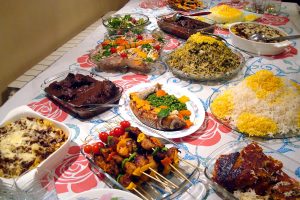Iranian eating habits are an interesting part of their cultural relations. In Iran, food is highly respected, and the table, the place where food is served, is respected. In Iranian food culture, it is generally believed that food is a blessing from God. Therefore, disrespect for food is equivalent to disrespect for God.
Besides, the tablecloth is a very valuable place in Iranian food culture as a place where family members spend three times a day interacting with each other. Eating alone is a sign of disrespect for family members, and disorders of family relationships are considered.
Join the Iran Travel Guide Center to Read more about Iranian eating habits. This article is a travel guide about the Persian diet.
Persian Cuisine History
for as much as this article is a guide to Persian food so, let us first know a little about Persian cuisine history. Like Persian carpets, Iranian cuisine is essentially a mass art, nurtured in the homes of simple or even poor people by the women and girls of the cities and villages of this land.
However, valuable examples (again, like a carpet) came from aristocrats’ and nobles’ homes. In Persian cuisine, the main difference between professional cooking and home cooking is in the volume of food, not in the way of cooking.
About Persian cuisine history, the oldest references to legends have started from the time of Zahak, and of course, before that in the history of cooking, tales were considered to be related to demons. But it is the oldest surviving manuscript about the history of Iranian cuisine and is related to the Sassanid era.
What are Iranian Eating Habits?
It is a collection of customs that discusses various topics such as food preparation and cooking, food storage, and food selection Iranian food is prepared so that its ingredients are tasted separately, and the spices’ aroma is well felt.
In the past, Iranians attached great importance to the taste and appearance of food, and the type of food they ate depended on the ingredients available in different seasons.
In Iran, as in other countries, there are particular foods for various ceremonies such as weddings, mourning, birthdays, New Year, and historical and religious banquets.
Highlights of Iranian Eating Habits
In the following guide to Persian food, we will review some important points of Iranian eating habits
-
Iranian Cuisine Based on Traditional Medicine
Iranians are good cooks. They have a wide variety of foods and use the most valuable and healthiest foods for cooking traditional food.
In traditional Iranian medicine, which is part of Persian cuisine history, all foods are naturally divided into four categories: wet, dry, hot, and cold. Accordingly, Iranians believe that the Persian diet should observe a balance in consuming various foods. Otherwise, the body and soul will suffer from illness and disease.
In Persian cuisine history, foods that balance each other’s temperament are called modifiers. This point is essential in Iranian food culture, and traditional foods have long been consumed with their modifier. For example, in the doctrine of traditional Iranian medicine, rice has a cold nature, and vegetables such as mint, leek, tarragon, basil, etc. have a warm character.
Therefore, a basket of vegetables, which includes several different types of vegetables with a warm nature, is often seen on the Iranians’ table and has become an integral part of the Persian diet.
-
Dining Equipment in Iran
In Iranian eating habits, the tablecloth is used instead of the dining table. Tablecloths are often made of Iranian fabrics such as Qalamkar, which are spread in the center of the rug; The dishes are placed on top of it, and family members sit around it and enjoy the main meals together.
Over the past few years, the use of plastic and disposable tablecloths has also become common. Today, due to lifestyle changes, the use of the dining table has become common and the tablecloth is used only in large family parties.
Iranians eat with spoons and forks, and Iranian food culture is such that the need to use a knife is rare. Some foods are first wrapped in bread, which is called a loghmeh. The loghmehs are eaten by hand. Some foods, such as broth and the Aash, are eaten without a fork and only with a spoon. Most meals are served on a plate. Soups and broths are also eaten in relatively large bowls.
Unlike Western culture, where appetizers, main dishes, and desserts are brought to the table at regular intervals, various foods are placed on the table simultaneously in Iranian eating habits.
The main food, appetizers, Iranian desserts, and drinks in Iranian food culture are placed on the table at once, and people use them in order.
Iranian food is often time-consuming and, like fast foods, is not prepared in a short time, and perhaps the reason for this coincidence lies in such a point.
In Iranian eating habits, some foods are forbidden and have no place in Persian cuisine history. Pork and all its by-products are forbidden, and its reason goes back to religious values.
Also, all kinds of alcoholic beverages are prohibited in Iran, and buying, selling, producing, and using them is a crime. Eating raw insects and seafood in natural form is also outside the scope of Iranian food culture and is not the majority of citizens’ taste.
-
Tea’s Role in Persian cuisine history
Iranians, like other people in the world, have two types of hot and cold drinks. Tea is the most popular hot drink in Iran. Iranians use black tea and traditionally use natural flavors such as rose petals or orange blossom and cinnamon sticks to make it fragrant.
Tea is used in Iran along with traditional sweets such as gaz, noghl, and candies. Sugar cubes are also the most available sweet for tea consumption. Tea is one of the main pillars of Iranian eating habits.
-
Iranian Drinks and Beverages
Coffee is also typical in some southern regions. The dough is also a traditional cold drink that goes well with the main meals. Herbal teas are also used as syrup when mixed with water and sugar. It can be said that traditional drinks and beverages have an essential part in Iranian food culture.
The food customs of the Iranian people are one of their cultural indicators. Also, washing hands before and after meals, sitting on the floor to eat, hospitality and compliments to guests, halal foods, observing calmness and silence during meals, and avoiding overeating are other characteristics of Iranian eating habits.





No comment